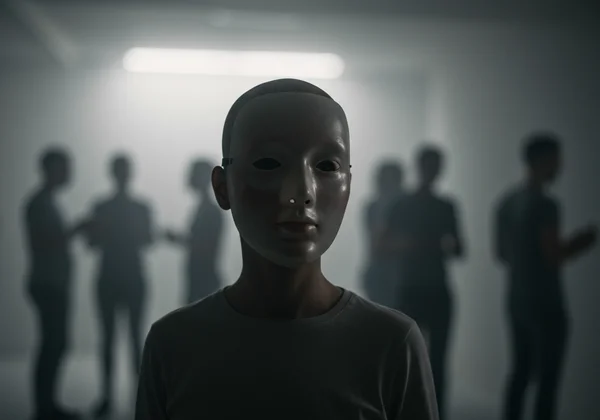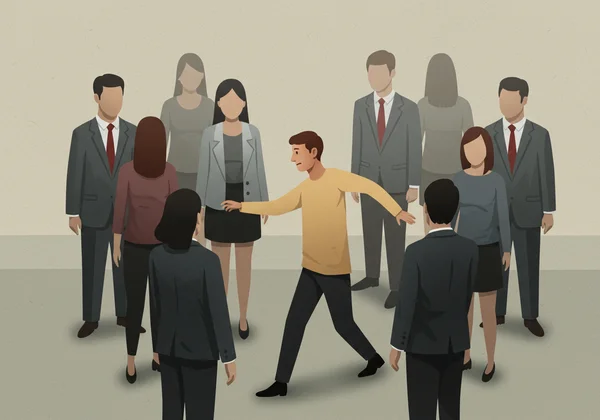Autistic Masking Explained: Understanding Your Traits with the AQ Test
Have you ever felt like you're playing a part in your own life? As if you've spent years studying a script for social interactions that everyone else seems to know by heart? This constant performance can be utterly exhausting, leaving you drained and disconnected from your true self. If this resonates with you, you may be experiencing a phenomenon known as autistic masking. What is autistic masking, and how can understanding it be the first step toward living a more authentic life? This journey of self-discovery often begins with asking the right questions, and gaining insight into your own traits can be a powerful catalyst for change. You can begin exploring those traits today with a free AQ test.
What Is Autistic Masking (Camouflaging)?
Autistic masking, also known as camouflaging, is a complex set of conscious and unconscious strategies used by some autistic individuals to hide or minimize their autistic traits. The goal is often to blend in with neurotypical peers and navigate a world that wasn't designed for them. It's more than just being polite; it's a deep-seated survival mechanism that involves actively suppressing natural behaviors and performing neurotypical ones.

Defining Camouflaging Behaviors in Autism
Camouflaging behaviors are the specific actions someone takes to mask. This isn't a one-size-fits-all strategy; it varies greatly from person to person. It often involves a combination of imitation, compensation, and suppression. An individual might meticulously copy the social behaviors of others, develop complex rules for conversation, or force themselves to suppress natural self-soothing behaviors, known as stimming.
Masking vs. Adapting: Understanding the Difference
It's crucial to distinguish between masking and simply adapting. Everyone adapts their behavior to different social contexts—you likely speak differently to your boss than you do to your best friend. However, adapting is usually a minor, low-effort adjustment. Masking, on the other hand, is a constant, high-effort performance that conceals core aspects of one's identity. It feels like wearing a heavy costume all day, every day.
Common Examples of Masking in Daily Life
To understand it better, consider these common examples of masking:
- Forcing or faking eye contact during conversations, even when it feels uncomfortable or overwhelming.
- Mentally scripting and rehearsing conversations before they happen.
- Mimicking the gestures, facial expressions, and tone of voice of others.
- Suppressing repetitive movements like hand-flapping or rocking.
- Pushing through sensory overload in noisy or bright environments without showing distress.
- Pretending to understand social cues or jokes when you don't.
Why Do Autistic Individuals Mask? Exploring the Motivations
Masking isn't a choice made lightly; it's often born from years of social feedback and a deep-seated need to connect and survive. The motivations behind it are multifaceted, stemming from both external pressures and internal drives. Understanding these reasons is key to developing compassion for oneself and others who mask.

Navigating Social Pressure and Seeking Acceptance
From a young age, many autistic individuals learn that their natural ways of being are considered "different" or "wrong." They may be corrected for not making eye contact or told their special interests are obsessive. This continuous feedback creates immense social pressure to conform. The desire for connection and acceptance is a fundamental human need, and masking can feel like the only way to achieve it.
The Drive to Avoid Stigma and Discrimination
Beyond simply wanting to fit in, masking is often a strategy to avoid negative consequences. Autistic people can face bullying, social exclusion, and even discrimination in school or the workplace. Masking becomes a shield, a way to protect oneself from misunderstanding and prejudice. It’s a tool for safety in a world that can be unwelcoming to neurodivergence.
Internalized Expectations and Identity Formation
Over time, external pressures can become internalized. An autistic person might start to believe that their authentic self is inherently flawed and that the mask is who they should be. This can lead to a fractured sense of identity, where it becomes difficult to distinguish between the mask and the true self.
The Heavy Toll: Mental Health Impacts of Persistent Masking
While masking can serve as a short-term survival tool, the long-term cost is incredibly high. The constant effort required to maintain this facade takes a significant toll on mental, emotional, and physical well-being. It is a leading contributor to many of the challenges faced by autistic adults.

Autistic Burnout, Exhaustion, and Energy Depletion
Imagine running a marathon every single day. That's what persistent masking can feel like. It consumes an enormous amount of cognitive and emotional energy, leading to profound exhaustion and a state known as autistic burnout. This is not just feeling tired; it's a state of chronic exhaustion that can result in a loss of skills, increased sensory sensitivity, and an inability to cope with daily life.
Increased Anxiety, Depression, and Loss of Self
Constantly monitoring your every move and suppressing your true identity is a recipe for anxiety. The fear of the mask slipping is always present. Over time, this can lead to depression and a profound loss of self. When you spend your life pretending to be someone else, it's easy to lose touch with who you are, what you enjoy, and what you truly need.
Challenges in Authentic Self-Expression and Relationships
Masking creates a barrier to genuine connection. When you're masking, people get to know the mask, not the real you. This can lead to feelings of loneliness and isolation, even when surrounded by people. Building authentic relationships becomes incredibly difficult because you're hiding the very parts of yourself that allow for true intimacy and understanding.
Beginning the Journey: How to Safely Unmask and Live Authentically
Unmasking is not about flipping a switch; it's a gradual and personal journey toward authenticity. It requires courage, self-compassion, and support. The goal is not to stop adapting entirely but to reduce the harmful masking that erodes your sense of self and drains your energy.

Cultivating Self-Awareness: Recognizing Your Masking Patterns
The first step is always awareness. Start paying attention to when and why you mask. What situations trigger it? How does it feel in your body? Recognizing these patterns is crucial. Tools designed for self-exploration can be invaluable here. Taking an online autism screening can provide a structured way to reflect on your traits and behaviors, offering a baseline for understanding your unique neurotype.
Building a Supportive Environment and Community
You don't have to unmask everywhere all at once. Start with safe spaces and trusted people. This could be a close friend, a family member, a therapist, or an online community of other autistic individuals. A supportive environment is one where you feel accepted and valued for who you are, without the mask.
Setting Boundaries and Prioritizing Self-Care
Unmasking often involves learning to set firm boundaries to protect your energy. This might mean leaving a loud party early, declining a social invitation when you're drained, or allowing yourself to stim freely when you need to. Prioritizing self-care and respecting your own needs is not selfish—it's essential for sustainable well-being.
Unmasking for Autistic Women: Unique Considerations
It’s important to acknowledge that unmasking for women can present unique challenges. Societal expectations often place a greater pressure on women to be socially adept and accommodating, leading to more intense and complex masking from a young age. This can often result in late or missed diagnoses. Recognizing these specific pressures is a vital part of the unmasking journey for many autistic women.
Finding Your Authentic Self: Life Beyond the Mask
Understanding autistic masking is like finding a map to a part of yourself you may have never known existed. It explains the exhaustion, the social anxiety, and the feeling of being an outsider. While the journey of unmasking is challenging, it is also a path to liberation, self-acceptance, and genuine connection. It's about reclaiming your energy and allowing your authentic self to shine.
This journey starts with self-knowledge. If you're ready to better understand your own social and communication styles, taking a step toward self-discovery can be empowering. Consider exploring your traits further. A great place to start is by taking the free AQ test to get your score and unlock personalized insights.
Frequently Asked Questions About Autistic Masking
What are the common signs that someone is masking their autism?
Common signs include forcing eye contact, having a rigid posture, mimicking others' social behaviors, having a different personality in public versus private, and feeling completely exhausted after social events. A person masking might also have very few, but intense, special interests that they rarely share with others.
Can autistic masking affect my AQ test score or self-perception?
Yes, it certainly can. If you've been masking for a long time, you might answer questions on a self-assessment based on your masked behaviors rather than your true feelings or instincts. Learning about masking can improve your self-perception, allowing for more honest self-reflection. This new awareness might lead to discover your results with a fresh perspective.
Why is masking often discussed more in relation to autistic women?
Masking is more commonly associated with autistic women because societal gender roles often pressure girls to be more socially intuitive and agreeable. This can lead them to develop sophisticated masking techniques from an early age, which is a significant reason why many autistic women and girls go undiagnosed for years.
What are the first steps to take if I want to stop masking?
The first steps are gentle and internal. Begin by identifying your masking behaviors without judgment. Find a safe person or space to practice unmasking in small ways. Connect with the autistic community online to learn from others' experiences. Most importantly, practice self-compassion; this is a long-term process of unlearning.
Is autistic masking a conscious decision or an automatic behavior?
It's both. For many, it starts as a conscious effort to fit in during childhood. Over years or even decades, these behaviors can become so ingrained that they feel automatic and unconscious. Part of the unmasking process involves bringing these automatic behaviors back into conscious awareness so you can choose a different response.
Disclaimer: The information provided in this article is for informational purposes only. The AQ test is a screening tool and is not a substitute for a professional medical diagnosis. If you have concerns, please consult with a qualified healthcare professional.